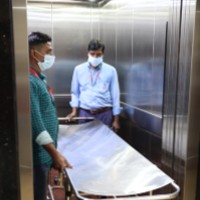- In hospitals, people with mobility problems and ill people can make use of the hospital lift.
- The medical equipment can also be transported soon within a short period of time.
- Lift in hospitals are manufactured in a way they are safe and has sufficient space for transferring the patients from one floor to other floors quickly.
- In this article, we’ll discuss the characteristics and measurements of a hospital lift.
- The characteristic of a hospital lift include efficiency, availability, accessibility, energy efficiency and electromagnetic compatibility.

The basic characteristics and measurements are as follows:
1. Efficiency and availability
For transferring the patients, beds, stretchers and food from one place to another we need different types of lifts in the hospital. The waiting time must be minimal in a hospital thus the task must be carried efficiently within a short period of time. The availability of shafts in the hospital must be more in number when compared to other commercial buildings.
2. Accessibility
The entry and exit of the stretchers must be hassle-free in hospitals. The efficiency of the door and door alarms in the lift for hospitals is a major factor for a safe journey. The shaft in the hospital lift must contain an additional wheelchair for people with mobility problems so that they can have easy access to the lift.
3. Energy efficient
In hospitals, the elevators are used for a long period of time. It is significant to assure the lift is energy efficient. The energy efficiency of an elevator can be calculated by variable frequency. In hydraulic traction, the power saving can be done using the variable frequency instead of the electric one.
4. Security
The hospital lifts carry people with mobility problems and sick people thus the shaft in the hospital lift must be safe and secure. In the shaft room, emergency buttons, alarms, emergency light, acoustic signalling and visual signalling are basic safety elements that need to be installed as rescue aid in an elevator. Safety is the fundamental aspect that every hospital lift manufacturers must know before installing the elevator in the hospital. Maintaining the elevator regularly is mandatory.
5. Electromagnetic compatibility and hygiene
The electromagnetic compatibility (EMC) in an elevator is lower. They also carry materials that carry electromagnetic waves. Infected people usually visit the hospital thus the hygiene of the elevator matters the most. The pit in the elevator must be waterproof and made up of antibacterial materials.
6. Measurements
Measurements of hospital lift depend upon the shaft. The shaft in hospital lift size ranges from 1600mm to 5200mm. The shaft in the hospital must be larger when compared to other elevators because they carry stretchers.








